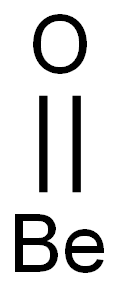A1222212
Beryllium oxide , 99% , 1304-56-9
CAS NO.:1304-56-9
Empirical Formula: BeO
Molecular Weight: 25.01
MDL number: MFCD00003457
EINECS: 215-133-1
Update time: 2022-07-08
PRODUCT Properties
| Melting point: | 2575°C |
||||||||||||||
| Boiling point: | 4300°C |
||||||||||||||
| Density | 3.01 g/mL at 25 °C(lit.) |
||||||||||||||
| refractive index | 1.733 |
||||||||||||||
| Flash point: | 4300°C |
||||||||||||||
| solubility | insoluble in H2O; slightly soluble in acid solutions, alkaline solutions |
||||||||||||||
| form | Powder |
||||||||||||||
| Specific Gravity | 3.01 |
||||||||||||||
| color | white |
||||||||||||||
| Water Solubility | Insoluble in water. Slowly soluble in concentrated acids, alkali hydroxides |
||||||||||||||
| Crystal Structure | Hexagonal, Wurtzite (Zincite) Structure - Space Group P 63mc |
||||||||||||||
| crystal system | Six sides |
||||||||||||||
| Merck | 14,1172 |
||||||||||||||
| Space group | P63mc |
||||||||||||||
| Lattice constant |
|
||||||||||||||
| Exposure limits | ACGIH: TWA 0.00005 mg/m3 OSHA: Ceiling 2 μg/m3 NIOSH: IDLH 4 mg/m3; Ceiling 0.0005 mg/m3 |
||||||||||||||
| Stability: | Stable. |
||||||||||||||
| CAS DataBase Reference | 1304-56-9(CAS DataBase Reference) |
||||||||||||||
| EPA Substance Registry System | Beryllium oxide (1304-56-9) |
Description and Uses
Beryllium oxide (BeO) is formed by the ignition of beryllium metal in an oxygen atmosphere. The resulting solid is colourless and insoluble in water.
Beryllium oxide?is widely used in industry due to its low density and high thermal and electrical conductivity. It is used in high-technology ceramics, electronic heat sinks, electrical insulators, high-power devices, high-density electrical circuits, microwaves, X-ray windows, nuclear reactor fuels and for various aerospace and military applications.
Safety
| Symbol(GHS) |   GHS06,GHS08 |
| Signal word | Danger |
| Hazard statements | H301-H315-H317-H319-H330-H335-H350i-H372 |
| Precautionary statements | P202-P260-P280-P302+P352-P304+P340+P310-P305+P351+P338 |
| Hazard Codes | T+ |
| Risk Statements | 49-25-26-36/37/38-43-48/23 |
| Safety Statements | 53-45 |
| RIDADR | UN 1566 6.1/PG 2 |
| WGK Germany | 1 |
| RTECS | DS4025000 |
| TSCA | Yes |
| HazardClass | 6.1 |
| PackingGroup | II |
| Hazardous Substances Data | 1304-56-9(Hazardous Substances Data) |



